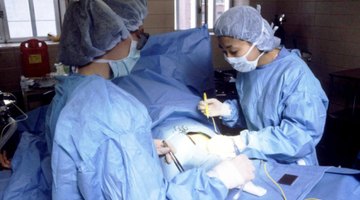Stomach Discomfort After a C-Section
Cesarean births are not unusual in the United States. Statistics from the Centers for Disease Control and Prevention released in 2007 show that almost a third of births involve c-section deliveries.
Yet while this procedure is common, it is not without significant risks to both women and their babies. If you are pregnant, it's important to be aware of the potential complications and effects of this procedure in the event you need a c-section during labor.
Identification
A cesarean section is a surgical procedure that requires incisions in both your abdomen and uterus to deliver your baby. This procedure is not usually planned in advance because physicians typically verify the need for it during the labor process.
Physicians recommend c-sections for several reasons, such as your baby being in an abnormal position or being too large for safe vaginal delivery. Other possible issues include problems with the umbilical cord, placenta and cervix.
In addition, if you or your baby have certain health problems, a c-section may be a better option that vaginal birth. Carrying multiple babies also creates a potential need for cesarean deliveries.
Risks

Long-Term Effects of Having a C-Section
Learn More
While having a c-section may be the best choice if vaginal delivery presents certain complications, this major surgical procedure has considerable risks for both you and your baby.
Inflammation of the uterus, infections at the incision sites, blood clots and allergic reactions to anesthesia are some of the potential problems accompanying a c-section. In addition, your baby is at higher risk for developing breathing problems such as transient tachypnea, according to MayoClinic.com.
Effects
Following surgery, you may experience a number of effects including confusion, trembling and drowsiness. These symptoms are more likely if you have to be put under general anesthesia for an emergency c-section. Stomach discomfort is also a common effect after a cesarean. This can include pain in the abdominal area as well as nausea. For a period of several days, you may also experience constipation and gas, which causes discomfort in the stomach and abdominal area as well.
Recuperation

Repercussions of Exercising Too Soon After a C-Section
Learn More
Recovering from a cesarean will center on protecting the abdominal incision from certain actions, such as lifting objects, coughing or laughing.
Although rest and limiting physical activity is important for recuperation, it's recommended that you begin walking as soon as you are able. This can help reduce constipation by encouraging bowel movements, which can lessen discomfort in the stomach area. However, if you're going to be walking, be sure to have someone available in the home in case of a problem. Be sure to check with your doctor before beginning physical activity.
Warning
The recovery process from a c-section typically takes several weeks. The uterus heals in about six to eight weeks, according to the Nemours Foundation's KidsHealth website.
While discomfort is a part of recuperation from this major surgery, there are certain signs of a serious problem that should not be ignored.
If you develop a fever, vaginal discharge, breast pain, heavy vaginal bleeding or signs of infection at the incision site, contact your physician. Get immediate medical attention if you have breathing problems, chest pain, leg swelling, or pain or redness in the legs, as this can signal the presence of a blood clot.











